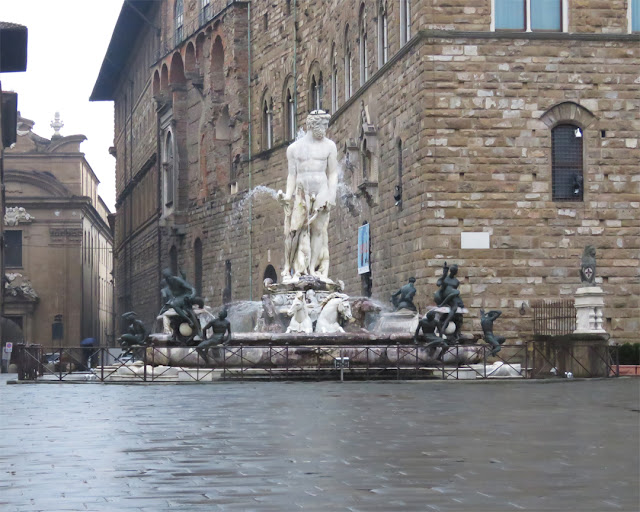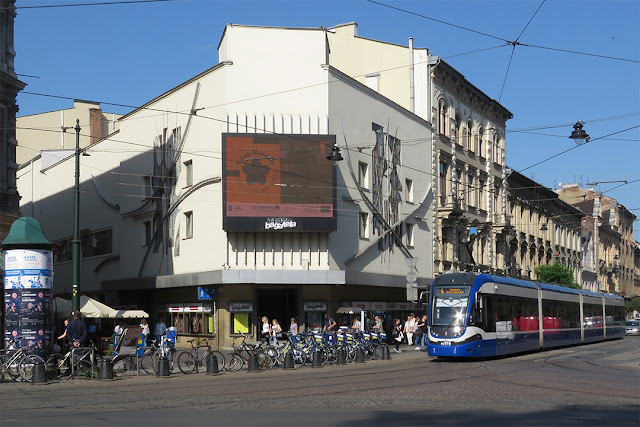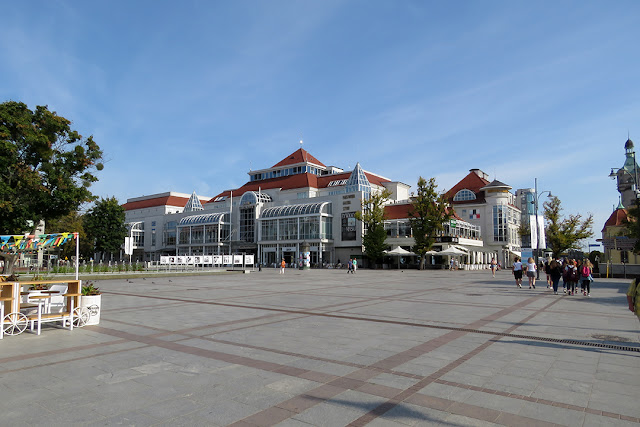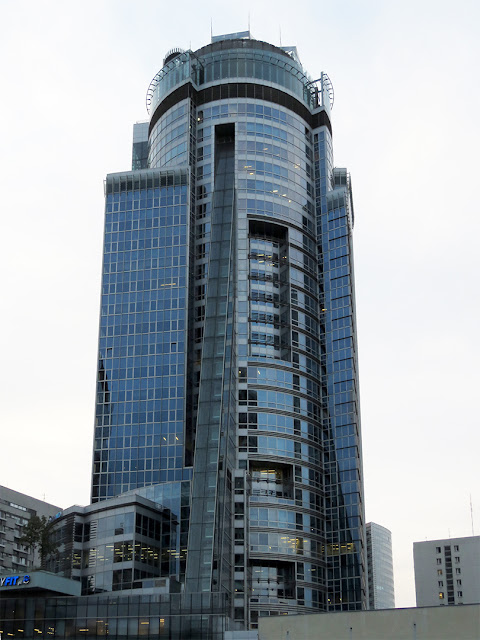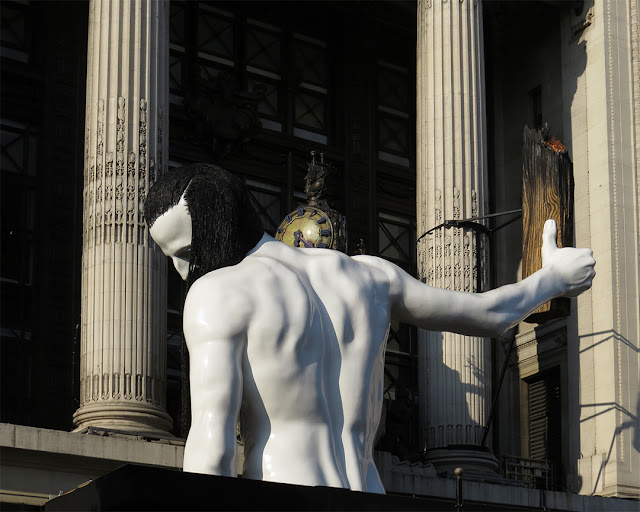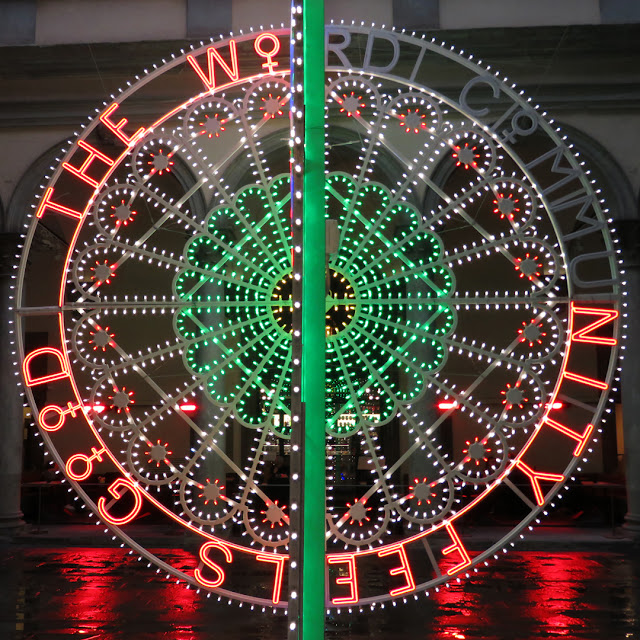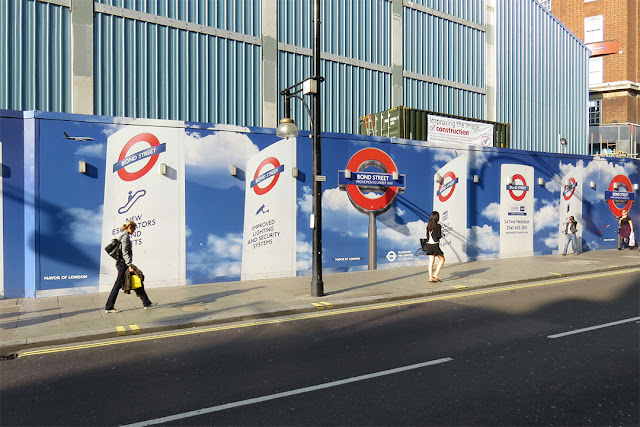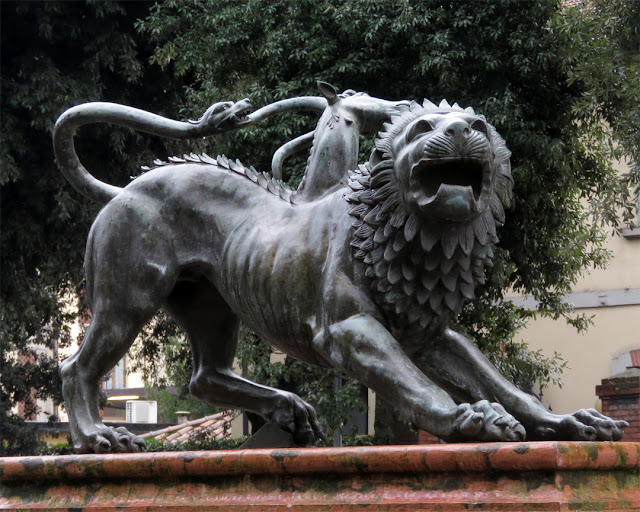Friday, December 31, 2021
Thursday, December 30, 2021
Piazza del Parlamento
Staircase with marble groups by Domenico Trentacoste, 1913
Palazzo Montecitorio
Piazza del Parlamento
Rome, September 2019
“The return of the Chamber of Deputies to the palace followed extensive renovations, which left only the facade intact. The architect, Ernesto Basile, was an exponent of Art nouveau, known in Italy as Liberty style. He reduced the courtyard, demolished the wings and rear of the palace, constructing a new structure dominated by four red-brick and travertine towers at the corners. Basile also added the so-called Transatlantico, the long and impressive salon which surrounds the debating chamber and now acts as the informal centre of Italian politics.” (Palazzo Montecitorio, Wikipedia)
Wednesday, December 29, 2021
Gdynia Market Hall
Hala Targowa (Market Hall)
ulica Wójta Radtkiego
Gdynia, September 2018
“One of the few places left in the Tri-city where you can get that authentic old time shopping experience. Inside this large Hala Targowa (Trading Hall), rows of independent traders offer everything from clothing to electronic equipment. Very popular with the visiting Swedish shoppers looking to pick up a bargain, the market is a glimpse into post-communist Poland before the arrival of the western style shopping malls and hypermarkets now so familiar across the region. Find it close to Gdynia Main Railway station.” (Gdynia Market Hall, In Your pocket)
Tuesday, December 28, 2021
Indomitable
Kodiak brown bear “Indomitable” by Nick Bibby
Oxford Street at Old Quebec Street
London, September 2014
“The creation of the monumental bronze sculpture, ‘Indomitable’, depicting a life-size Kodiak Brown Bear, has been a mammoth undertaking, requiring the talents of Nick and over 100 skilled workers at Pangolin Editions foundry in Chalford, Gloucestershire, to bring to reality. Involving over 3,000 hours work by Nick and the team at Pangolin; weighing over 5000 lbs and towering to 15 feet in height, the finished bronze sculpture projects an almost unbelievable aura of power and majesty, deeply affecting all who see it. Originally commissioned by Brown University, Providence, Rhode Island, Nick began by sculpting a 1/5th scale Maquette of the bear in water-based clay, which was then moulded and cast by Pangolin. This cast was laser scanned to provide computer data, used to create an exact digital enlargement of the bear in urethane foam. This foam enlargement was then covered with a thin layer of wax by Pangolin’s talented modellers, to provide a key for the final layer of wax modelling clay, added by Nick to sculpt the intense detail and texture of the finished bear. The completed monumental foam and wax sculpture was cut apart for moulding and casting into bronze. The bronze bear was cast in 12 separate sections, using over 2500lbs of bronze, the head and paws were cast using the cire perdu or, ‘Lost Wax’ method, whilst the two body sections were cast using giant sand moulds. The various sections were subsequently welded together and the welds skilfully re-detailed, prior to being patinated and attached to the massive fabricated sheet bronze and stainless steel plinth, using huge stainless steel bolts. Indomitable number 1 now stands proudly, outside the Nelson Fitness Centre, on Brown’s University Campus, in Providence, and a second cast has already been sold, which was recently on show near Marble Arch, on Oxford Street, London.” (Kodiak Brown Bear - Indomitable, Nick Bibby)
Monday, December 27, 2021
Fountain of Neptune
Fountain of Neptune by Bartolomeo Ammannati
Piazza della Signoria
Florence, February 2021
“The Fountain of Neptune in Florence, Italy, (Fontana del Nettuno) is situated in the Piazza della Signoria (Signoria square), in front of the Palazzo Vecchio. The fountain was commissioned by Cosimo I de' Medici in 1559 to celebrate the marriage of Francesco de' Medici I to Grand Duchess Joanna of Austria. Cosimo I de' Medici was the Duke of Florence from 1537-1569 and responsible for a vast number of architectural and artistic elements in Florence that still exist today. The fountain was designed by Baccio Bandinelli, but created by Bartolomeo Ammannati with the assistance of several other artists between 1560 and 1574. It incorporates a series of mythological figures and iconographies that symbolize both Cosimo I de' Medici's power and the union of Francesco and Joanna. It has sustained a great deal of damage over the years due to vandalism and general mistreatment but underwent a major restoration completed in 2019 that restored it to its original glory.” (Fountain of Neptune, Wikipedia)
Sunday, December 26, 2021
Saturday, December 25, 2021
Teulada
“Teulada” by Perejaume (Pere Jaume Borrell i Guinart), 1990
Jardí d'Escultures
Avinguda Miramar, Montjuïc
Barcelona, March 2017
“Pere Jaume Borrell i Guinart, known as Perejaume, (born in 1957 in Sant Pol de Mar, Catalonia) is a Spanish contemporary artist. Of self-taught formation he takes clear influences of authors like Joan Brossa, with whom he will share work mixing the painting and the poetry. His work covers a discursive plane of subject matter that includes humans' relationship with nature, the society of the spectacle, and the reevaluation of modernist painting. He has been exhibiting his work around the world since 1990 in such institutions as the Arnolfini Gallery in Bristol, England, the Meyers Bloom Gallery in Santa Monica, California and the Galeria Joan Prats in Barcelona, Catalonia. In 2005 he was awarded the Catalan National Prize of Visual Arts (granted by the Generalitat de Catalunya), in 2006 the Spanish National Award for Plastic Arts, and in 2007 the Spanish National Prize of Graphic Arts.” (Perejaume, Wikipedia)
Friday, December 24, 2021
Deer head
Deer head with a cross by Paolo Morelli
Basilica di Sant'Eustachio (Basilica of Saint Eustace)
Piazza di Sant'Eustachio
Rome, September 2019
“On top is a triangular pediment with in its middle a circular window surrounded with palm branches and surmounted by a crown. On top of the pediment stands a deer head with a cross between the antlers (done by the sculptor Paolo Morelli († 1719), in reference to the legend of Saint Eustace.” (Sant'Eustachio, Wikipedia)
Thursday, December 23, 2021
Bagatela Theatre
Teatr „Bagatela” (Bagatela Theatre)
ulica Karmelicka / ulica Krupnicza
Kraków, September 2018
“The Bagatela Theatre in Kraków is situated at the junction of Karmelicka Street and Krupniczej Street. The theatre's intimate ‘new stage’ is located on Sarego Józefa Street. The theatre's history dates back to 1918, when Marian Dąbrowski, publisher and editor of Kraków's ‘Ilustrowany Kurier Codzienny’ (Illustrated Daily Courier, commonly known as IKC, also Ikac) initiated the creation of the stage. The building was designed by architect Janusz Zarzecki during 1918 - 1919, and its interior was designed by painter and decorator Henry Uziembło. A fire that broke out the night of 6/7 April 1928 completely destroyed the interior. In 1926, due to financial difficulties, the theatre was reclassified as a cinema. In 1938, the building was modernized and renamed ‘Scala’. It became the most elegant cinema in Kraków. Housed here during 1946 - 1948 was an intimate theatre. Since 1949 it has been home to the Państwowy Teatr Młodego Widza (State Theatre of the Young Viewer). The Rozmaitości Theatre was established here in 1957. The theatre returned to being called Bagatela in 1970, and was dedicated to the memory of Tadeusz Boy-Żeleński in 1972. The writer and doctor lived in a flat in the area for many years. Roman Polanski made his debut here as a young man. The theatre was originally designed for children but nowadays shows musicals, comedies and other light entertainments suitable for families.” (Bagatela Theatre, Wikipedia)
Wednesday, December 22, 2021
Wright Eclipse Gemini
Volvo B5LH Wright Eclipse Gemini 2
Oxford Street
London, September 2014
“The Wright Eclipse Gemini is a low-floor double-decker bus body that was built by Wrightbus since 2001, based on the single-deck Wright Eclipse design. The second-generation Eclipse Gemini 2 was launched in 2009, followed by the third-generation Gemini 3 in 2013. Additionally, the body was available on Volvo Super Olympian chassis in Hong Kong between 2003 and 2005, marketed as the Wright Explorer. Production of the Gemini have been suspended as Wrightbus entered administration in September 2019. The original Eclipse Gemini was launched in 2001 on Volvo B7TL chassis; from 2006, the body was also built on the replacement Volvo B9TL chassis and, from 2013, on the B9TL's replacement, the Volvo B5TL. From 2008, the body was also available on Volvo B5LH hybrid chassis. Eclipse Gemini's exported to the Asian market have been offered a choice of the tri-axle Volvo B8L and the Scania K410EB. Wright Eclipse Gemini bodied buses were mass-introduced on London Buses services from 2001. It has also been popular with FirstGroup, who from 2003 onwards have purchased over 1,200 into service.[3] Dublin Bus and Bus Éireann have also acquired many Volvo B9TLs with Wright Eclipse Gemini bodywork.” (Wright Eclipse Gemini, Wikipedia)
Tuesday, December 21, 2021
Fontana del Mascherone
Fontana del Mascherone (Mask Fountain), 1764
Piazza del Grano
Florence, February 2021
“On the Northwest corner is a small marble fountain, Fontana del Mascherone, with a grotesque face, designed and sculpted by Chiarissimo Fancelli, inspired by the Fontana dello Sprone in Oltrarno that had been built by Bernardo Buontalenti.” (Loggia del Grano, Wikipedia)
Monday, December 20, 2021
Sunday, December 19, 2021
Saturday, December 18, 2021
The Quadriga of Liberty
The Quadriga of Liberty by Luigi Bartolini, 1927
Victor Emmanuel II Monument
Piazza Venezia
Rome, June 2019
“At 11 metres tall, the Quadriga soars over the western propylaeum of the monument, its silhouette, inspired by ancient Greek models, stands out against the Roman sky. The Quadriga of Liberty, which is over 11 metres tall, was made of bronze by the Roman sculptor Paolo Bartolini. After winning the special competition in 1907, Bartolini began working on the piece in 1909. However, final delivery and assembly of the work of art were not completed until 1927. Liberty is represented as a Victory with outstretched wings, her head surrounded by a band, known as a taenia, with a laurel wreath in one hand and a spear in the other; she is standing on a wagon pulled by four majestic horses. The model for the female figure is the Lemnian Athena, which, since antiquity, has been considered the masterpiece of the great Greek sculptor Fidia: Bartolini was able to study it closely through a cast of the preserved copy in Dresden.” (The Quadriga of Liberty, Vittoriano)
Friday, December 17, 2021
Spektrum Tower
Spektrum Tower, 2003
Twarda, Warszawa-Śródmieście
Warsaw, September 2018
“The Spektrum Tower (formerly TP S.A. Tower) is a highrise office tower in Warsaw, the capital of Poland. It is located at 14/16 Twarda Street in the Warszawa-Śródmieście central business district of the city and used to house the headquarters of its investor, the telecom operator Telekomunikacja Polska S.A. (TP S.A.), with some space being leased to other companies. The building of the tower was initially contracted to PIA Piasecki S.A. on 1 August 1997, originally due to be completed 30 June 2002. In 2002, however, the contractor was found unable to complete the structure due to strained financial standing, and the investor turned to PORR Polska S.A. (who has completed a number of other office buildings and towers in Warsaw) to finish the construction. The Tower was finally completed in December 2003. The Tower was built using the ‘top-down’ technology, with both the over- and underground parts of the structure being constructed simultaneously. During the excavation for the foundation of the Tower, a 580 kg artillery shell from World War II was discovered 8 metres below ground level. The Tower was designed by architects from Apar-Projekt and Arca A&C bureaus, and consists of a composition of cylinders and cuboids. The structural design was the responsibility of TMJ Tomasz Ziętała. The Tower has 30 overground and 5 underground floors, extending 16.5 metres below ground level and rising to 128 metres above ground. The building comprises almost 50,000 m2 of space, over 41,000 of which is usable. Unique features of the building include the helipad on the roof and the external elevator shaft, sloped 14°, which connects the street level with one of the higher office floors with an elevator cabin travelling at 2.5 m/s. Apart from it, there are seven other straight-up elevator shafts in the building core. The Tower is a modern intelligent building, fitted with building automation systems. In July 2008 it was sold to Danish investment fund Baltic Property Trust Optima which sold it in 2012 to a London-based Europa Capital LLP fund.” (Spektrum Tower, Wikipedia)
Thursday, December 16, 2021
Rick Owens
Rick Owens by Douglas Jennings, 2014
Selfridges
Oxford Street
London, September 2014
“Rick Owens has been immortalised by a 25 foot polystyrene sculpture on top of Selfridges' Oxford Street entrance. The naked torso was created from a maquette designed by the British sculptor Doug Jennings, and features a flaming torch that will burn for 12 hours a day, for a total of 552 hours. The statue is the pièce de résistance of ‘The World of Rick Owens’, a new collaboration between Rick Owens and Selfridges that marks twenty years since the Californian designer launched his eponymous label. He's also curated a series of window designs for the department store; three are influenced by the Richard Strauss opera Salome.” (Today in London: Rick Owens x Selfridges, FashionUnited)
Wednesday, December 15, 2021
Palazzo Spini Feroni
Palazzo Spini Feroni
Piazza di Santa Trinita
Florence, February 2021
“In the 14th century, the palazzo was divided between the two branches of the Spini; the section facing the piazza was sold in the 17th century. In the 1670s, Marquis Francesco Antonio Ferroni, a member of Grand Duke Cosimo III ruling circle, had it redecorated with stuccoes by Giovan Battista Foggini and Lorenzo Merlini. During this refurbishment, the frescoes (1609–1612) by Bernardino Poccetti depicting Paradise with a Choir of Musician Angels and Adoration of the Shepherds were moved from their original location. In 1846, after a spell as a hotel, the palace was purchased by the comune of Florence, and later used for state offices during the period (1865–1871) when Florence was capital of Italy. In 1874, it was partly renovated in neo-medieval style; shop-fronts were opened in the ground floor and a tower and an arch facing the river Arno were demolished, giving the palace the present appearance. In the 1930s, it was bought by the shoe designer Salvatore Ferragamo. Since 1995 the Palazzo has housed a museum dedicated to Ferragamo.” (Palazzo Spini Feroni, Wikipedia)
Tuesday, December 14, 2021
Sukiennice
Sukiennice (Cloth Hall)
Rynek Główny
Stare Miasto (Old Town)
Kraków, September 2018
“The Kraków Cloth Hall (Polish: Sukiennice), in Lesser Poland, dates to the Renaissance and is one of the city's most recognizable icons. It is the central feature of the main market square in the Kraków Old Town (the historic center of Kraków), which since 1978 has been listed as a UNESCO World Heritage Site). It was once a major centre of international trade. Travelling merchants met there to discuss business and to barter. During its golden age in the 15th century, the hall was the source of a variety of exotic imports from the east – spices, silk, leather and wax – while Kraków itself exported textiles, lead, and salt from the Wieliczka Salt Mine. In the immediate vicinity of the hall, the Great Weigh House and the Small Weigh House existed until the 19th century. Other, similar cloth halls have existed in other Polish as well as other European cities such as in Ypres, Belgium; Braunschweig, and in Leeds, England. Kraków was Poland's capital city and was among the largest cities in Europe already from before the time of the Renaissance. However, its decline started with the move of the capital to Warsaw at the end of the 16th century. The city's decline was hastened by wars and politics leading to the Partitions of Poland at the end of the 18th century. By the time of the architectural restoration proposed for the cloth hall in 1870 under Austrian rule, much of the historic city center was decrepit. A change in political and economic fortunes for the Kingdom of Galicia and Lodomeria ushered in a revival due to newly established Legislative Assembly or Sejm of the Land. The successful renovation of the Cloth Hall, based on a design by Tomasz Pryliński and supervised by Mayor Mikołaj Zyblikiewicz, Sejm Marshal, was one of the most notable achievements of this period. The hall has hosted many distinguished guests over the centuries and is still used to entertain monarchs and dignitaries, such as Charles, Prince of Wales and Emperor Akihito of Japan, who was welcomed here in 2002. In the past, balls were held here, most notably after Prince Józef Poniatowski had briefly liberated the city from the Austrians in 1809. Aside from its history and cultural value, the hall still is still used as a center of commerce.” (Kraków Cloth Hall, Wikipedia)
Monday, December 13, 2021
Sunday, December 12, 2021
The Quadriga of Unity
The Quadriga of Unity by Carlo Fontana, 1927
Victor Emmanuel II Monument
Piazza Venezia
Rome, June 2019
“All of Rome at your feet: this is the Terrace of the Quadrigae. At the end of an exciting ride, the panoramic lifts take you to the top of the Vittoriano, with a 360° view of the Eternal City. The terrace takes its name from the two 11-metre-high bronze quadrigae located on the top of the two propylaea. The Quadriga of Unity, to the east, was made of bronze by the sculptor from Carrara, Carlo Fontana (1909-1927). Unity is represented as a classical Victory with outstretched wings and a laurel wreath, standing on a chariot pulled by four horses that stride forward in a dignified manner. The western end is dominated by the Quadriga of Liberty made of bronze by the Roman sculptor, Paolo Bartolini (1909-1927). Liberty is also represented as a Victory with outstretched wings, her head surrounded by a band, known as a taenia, with a laurel wreath in one hand and a spear in the other; she is standing on a chariot pulled by four majestic horses.” (Terrace of the Quadrigae, Vittoriano)
Saturday, December 11, 2021
Friday, December 10, 2021
South Molton Street Building
South Molton Street Building by DSDHA, 2013
South Molton Street and Davies Street, Mayfair
London, September 2014
“The South Molton Street Building is a new mixed-use development located on Oxford Street, London’s busiest shopping thoroughfare, at the junction with South Molton Street and Davies Street. It is adjacent to Bond Street Underground Station, which will benefit from the arrival of Crossrail in 2018 and an influx of additional visitors to the area. The development replaces a former pub with a new high quality mixeduse building comprising retail, office space and residential. The six-storey building is the brand headquarters and flagship store for Bosideng, China’s largest retailer (which has over 4000 outlets in China), introducing the brand to an international audience. The design responds to the building’s unique location, its surrounding context within Mayfair and proximity to the historic route of the buried River Tyburn. Seeking to reflect the qualities of the area, it presents a contemporary sustainable architecture that embodies good design and craftsmanship. Sited within a Conservation Area and highly prominent from all sides, there are five separate approach routes to the South Molton Street Building. DSDHA has taken a three-dimensional approach based on the kinetic experience of seeing and walking past the building from different points of view. Bookending a pedestrianised street, the form of the building is created to improve the status of the address, and as the facade gracefully turns the curved corner facing Oxford Street it reveals greater transparency on the retail and residential floors, evoking a sense of movement and change across the elevation. From Davies Street, a distinct residential and commercial entrance is created to visually terminate the street when approached from Brook Street and Berkeley Square. The facade is composed of subtly varying profiled glazed terracotta tiles, designed specifically for the project in close collaboration with the manufacturer. Taking inspiration from the aqueous historic reference of the River Tyburn flowing along South Molton Street, the bespoke facade has been developed to create a perceived sense of movement or undulation as you pass by. The glazed battens are shaped to capture shadow and reflect light to create a dynamic and ever-changing elevation.” (The South Molton Street Building, Archello)
Thursday, December 9, 2021
We Rise by Lifting Others
“We Rise by Lifting Others” by Mariella Senatore, 2020
Palazzo Strozzi
Piazza degli Strozzi
Florence, February 2021
Wednesday, December 8, 2021
Tuesday, December 7, 2021
Font de Rut
Font de Rut (Fountain of Ruth) by Josep Maria Camps i Arnau, 1949
Plaça de la Virreina
Barcelona, March 2017
Monday, December 6, 2021
Statue of Saint Paul
Bronze statue of Saint Paul by Costantino de' Servi, 1586
Column of Marcus Aurelius
Piazza Colonna
Rome, June 2019
“About three metres of the base have been below ground level since 1589 when, by order of pope Sixtus V, the whole column was restored by Domenico Fontana and adapted to the ground level of that time. Also a bronze statue of the apostle St. Paul was placed on the top platform, to go with that of St. Peter on Trajan's Column (27 October 1588). (Originally the top platform had a statue of Marcus Aurelius, but it was removed and switched with St.Paul after Christianity took reign as the dominant religion.)” (Column of Marcus Aurelius, Wikipedia)
Sunday, December 5, 2021
Wojciech Bogusławski
Pomnik Wojciecha Bogusławskiego (Monument to Wojciech Bogusławski)
plac Teatralny
Warsaw, September 2018
“Wojciech Romuald Bogusławski (9 April 1757 – 23 July 1829) was a Polish actor, theater director and playwright of the Polish Enlightenment. He was the director of the National Theatre, Warsaw, (Teatr Narodowy), during three distinct periods, as well as establishing a Polish opera. He is considered the ‘Father of Polish theatre.’” (Wojciech Bogusławski, Wikipedia)
Saturday, December 4, 2021
Friday, December 3, 2021
Chimera of Arezzo
Chimera of Arezzo (copy)
Giardini del Porcinai
Viale Michelangelo
Arezzo, February 2021
“The Chimera of Arezzo is regarded as the best example of ancient Etruscan artwork. British art historian, David Ekserdjian, described the sculpture as "one of the most arresting of all animal sculptures and the supreme masterpiece of Etruscan bronze-casting." Made entirely of bronze and measuring 78.5 cm high with a length of 129 cm, it was found alongside a small collection of other bronze statues in Arezzo, an ancient Etruscan and Roman city in Tuscany. The statue was originally part of a larger sculptural group representing a fight between a Chimera and the Greek hero Bellerophon. This sculpture was likely created as a votive offering to the Etruscan god Tinia.” (Chimera of Arezzo, Wikipedia)
Thursday, December 2, 2021
Muzyka
“Muzyka” (Music)
Filharmonia Krakowska (Kraków Philharmonic)
ulica Zwierzyniecka
Kraków, September 2018
“The Kraków Philharmonic (Polish: Filharmonia Krakowska) is the primary concert hall in Kraków, Poland. It is one of the largest auditoriums in the city. It consists of the main hall for orchestral performances with 693 seats, and two smaller venues, the Golden Hall and the Blue Hall, for chamber music concerts. The Kraków Philharmonic Concert Hall was designed by architect Józef Pokutynski, with neo-baroque elements inspired by the Brussels' Maison du Peuple. It was sponsored by Prince and Cardinal Adam Stefan Sapieha, and completed 1931. In 1996, a new 50-pipe organ was installed in the hall, replacing an older one by Karl Schuke. It was designed and built by Klais Orgelbau of Bonn, a family-run company specializing in large-scale projects across the globe. The concert hall is home of the Kraków Philharmonic Orchestra as well as the chamber Capella Cracoviensis.” (Kraków Philharmonic, Wikipedia)
Wednesday, December 1, 2021
Església de Sant Joan
Església de Sant Joan
Plaça de la Virreina
Barcelona, March 2017
“Construction on this striking church began in 1878 and was completed in 1884. It was designed by Francesc Berenguer i Mestres, Gaudí's protégé, but it's believed that the interior chapel is the work of Gaudí himself (the jury is still out, however). What is certain is that Gaudí regularly worshipped here. Much of the church was damaged during the 1909 Setmana Tràgica and again in 1938, though the chapel survived unscathed, and rebuilding wrapped up in 1951.” (Església de Sant Joan, Lonely Planet)
Subscribe to:
Posts (Atom)





